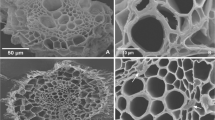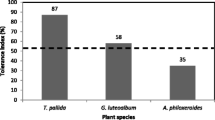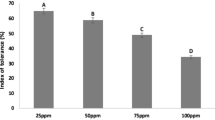Abstract
The chromium bioaccumulation ability of Leersia hexandra was assessed and the chromium distribution in the deferent chemical forms in plant tissues was determined. The hydroponic experimental results indicated that the maximum chromium concentration in the dry leaf matter of Leersia hexandra reached 4302 mg kg−1. Chromium treatment could significantly increase the proportions of oxalic integrated chromium in leaves and residue chromium in roots, which might be related to the high resistance and bioaccumulation capacity for chromium in Leersia hexandra.
Similar content being viewed by others
References
Baker AJM, Brooks RR (1989) Terrestrial higher plants which hyperaccumulate metallic elements-a review of their distribution, ecology and phytochemistry. Biorecovery 1:81–97
Baker AJM, McGrath SP, Sidoli CMD, Reeves RD (1994) The possibility of in situ heavy metal decontamination of polluted soils using crops of metal-accumulating plants. Resour Conserv Recy 11:41–49. doi:10.1016/0921-3449(94)90077-9
Clemens S, Palmgren MG, Krämer U (2002) A long way ahead: understanding and engineering plant metal accumulation. Trends Plant Sci 7:309–315. doi:10.1016/S1360-1385(02)02295-1
Krämer U, Pickering IJ, Prince RC, Raskin I, Salt DE (2000) Subcellular localization and speciation of nickel in hyperaccumulator and non-accumulator Thlaspi species. Plant Physiol 122:1343–1353. doi:10.1104/pp.122.4.1343
Liu J, Xiong Z, Li T, Huang H (2004) Bioaccumulation and ecophysiological responses to copper stress in two populations of Rumex dentatus L. from Cu contaminated and non-contaminated sites. Environ Exp Bot 52:43–51. doi:10.1016/j.envexpbot.2004.01.005
Lytle CM, Lytle FW, Yang N, Qian JH, Hansen D, Zayed A, Terry N (1998) Reduction of Cr(VI) to Cr(III) by wetland plants: potential for in situ heavy metal detoxification. Environ Sci Technol 32:3087–3093. doi:10.1021/es980089x
Ma JF, Zheng SJ, Matsumoto H (1997) Defoxifying aluminum with buckwheat. Nature 390:569–570. doi:10.1038/37518
Reeves RD (2003) Tropical hyperaccumulators of metals and their potential for phytoextraction. Plant Soil 249:57–65. doi:10.1023/A:1022572517197
Skeffington RA, Shewry PR, Peterson PJ (1976) Chromium uptake and transport in barley seedlings (Hordeum vulgare L.). Planta 132:209–214. doi:10.1007/BF00399719
Tang SR, Wilke BM, Huang CY (1999) The uptake of copper by plants dominantly growing on copper mining spoils along the Yangtze River, the People’s Republic of China. Plant Soil 209:225–232. doi:10.1023/A:1004599715411
Tolra RP, Poschenrieder C, Barcelo M (1996) Zinc hyperaccumulation in Thlaspi caerulescens, II. Influence on organic acids. J Plant Nutr 19:1541–1550
Wei SH, Zhou QX, Wang X, Zhang KS, Guo GL, Ma LN, Qi Y (2005) A newly-discovered Cd-hyperaccumulator Solanum nigrum L. Chinese Sci Bull 50:33–38. doi:10.1360/982004-292
Yang JR, He JQ, Zhang GX, Mao XQ (1995) Tolerance mechanism of crops to Cd pollution. Chinese Journal of Applied Ecology 6:87–91 in Chinese
Zayed A, Lytle CM, Qian JH, Terry N (1998) Chromium accumulation, translocation and chemical speciation in vegetable crops. Planta 206:293–299. doi:10.1007/s004250050403
Zhang XH, Liu J, Huang HT, Chen J, Zhu YN, Wang DQ (2007) Chromium accumulation by the hyperaccumulator plant Leersia hexandra Swartz. Chemosphere 27:1138–1143. doi:10.1016/j.chemosphere.2006.11.014
Zhang XH, Luo YP, Huang HT, Liu J, Zhu YN, Zeng QF (2006) Leersia hexandra Swartz: a newly discovered hygrophyte with chromium hyperaccumulator properties. Acta Ecologica Sinic 26:950–953 in Chinese
Acknowledgements
The authors thank the financial supports from the Scientific Research and Technological Development Project of Guangxi (GuiKeGong 0816003-1-1), the Natural Science Foundation of China (No.40663002, 20665003) and the Provincial Natural Science Foundation of Guangxi (GuiKeNeng 0701K005, GuiKeZi 0728222). Financial assistance for this research was also provided through the Program to Sponsor Teams for Innovation in the Construction of Talent Highlands in Guangxi (GuiKeRen 2007-71, 2004217).
Author information
Authors and Affiliations
Corresponding author
Additional information
Xuehong Zhang, Jie Liu these authors contributed equally to this work.
Rights and permissions
About this article
Cite this article
Zhang, X., Liu, J., Wang, D. et al. Bioaccumulation and Chemical Form of Chromium in Leersia hexandra Swartz. Bull Environ Contam Toxicol 82, 358–362 (2009). https://doi.org/10.1007/s00128-008-9587-2
Received:
Accepted:
Published:
Issue Date:
DOI: https://doi.org/10.1007/s00128-008-9587-2




